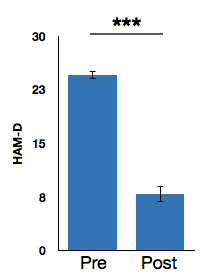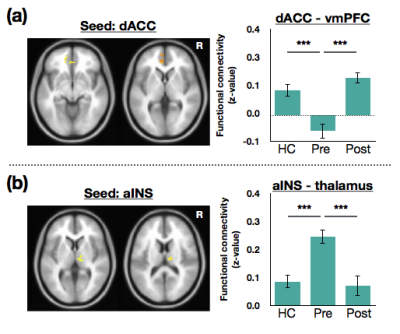0232
Sertraline treatment modulates salience connectivity in major depressive disorder1Brain and Consciousness Research Center, Taipei Medical University, Taipei, Taiwan, 2GE Healthcare, Taipei, Taiwan, 3National Yang-Ming University, Taipei, Taiwan, 4Department of Radiology, National Defense Medical Center, Taipei, Taiwan
Synopsis
How sertraline alleviates depressive syndrome by modulating the intrinsic connectivity networks (ICNs) remains elusive. Herein, we take a network-based investigation on SN to rationalize the functional and behavior effect of the sertraline treatment using resting-state functional connectivity (rsFC). Our study demonstrated that the sertraline treatment exhibited beneficial modulations on the DNMTL–SN–thalamus pathway for alleviating depressive syndromes in MDD patients.
Introduction
Sertraline, one of the oldest antidepressants, is widely used for the treatment of major depressive disorder (MDD). However, how sertraline alleviates depressive syndrome by modulating the intrinsic connectivity networks (ICNs) remains elusive. Previous literature emphasizes on the amygdala dysfunctions in MDD patients, but other networks (1-2), such as salience network (SN), could be involved in conscious perceptions on salient stimuli and interceptive information to guide motivated behavior (2-3). Herein, we take a network-based investigation on SN to rationalize the functional and behavior effect of the sertraline treatment using resting-state functional connectivity (rsFC).Methods
We included 22 unmedicated MDD patients with Hamilton depression rating scale for depression (HAM-D) score and 35 healthy control (HC). The fMRI scans were acquired before (Pre) and after (Post) 6-week sertraline treatment in MDD patients by 3T MR scanner (GE, Discovery MR750) with 8-channel head-neck-spine coil (RS-fMRI with EPI sequence: 200 measurements, TR/TE = 2500/30 ms). We applied seed-correlation on preprocessed rs-fMRI images. The seed of dACC and aINS within SN were selected from the combination of SN component in 20-component ICA analysis and Broadmann atlas. Group comparisons were conducted by a mixed analysis of variance (ANOVA) on the Z-map of RS-fMRI across HC, Pre, and Post groups. (p<0.05, corrected)Results and discussion
Results of sertraline treatment on MDD is shown in Figure 1. The significant decrease in HAM-D score in Post group implies an effective treatment. Compared with the Pre group, the functional connectivity in the Post group showed increased connection between dACC and ventromedial PFC (vmPFC) (Fig. 2a), which was previously shown as one hub within subsystem of default network (DNMTL) involved in the emotional regulation with dACC (4-5). Hence, sertraline acts through improving the motivation of MDD patients. In addition, decreased connection between aINS and right thalamus was observed in the Post group (Fig. 2b). The aINS was previously shown as a hub for meta-awareness and affective processing and has long been associated with MDD pathophysiology (3). Moreover, the aINS-thalamus connection plays an important ‘alerting’ role in salience detection (6). Hence, sertraline acts through lowering the inter-network connectivity for MDD paranoid behavior.Conclusion
In this study, the connection of dACC-vmPFC and aINS-thalamus showed positive and negative sertraline treatment effect, respectively. Our study demonstrated that the sertraline treatment exhibited beneficial modulations on the DNMTL–SN–thalamus pathway for alleviating depressive syndromes in patients with MDD.Acknowledgements
This study is supported by Taiwan Ministry of Science and Technology (MOST 106-2420-H-038 -005 -MY2, MOST 106-2632-H-038-001 -MY3, and MOST 104-2420-H-038-001-MY3)References
1. Victor TA, Furey ML, Fromm SJ, Ohman A, & Drevets WC (2010) Relationship between amygdala responses to masked faces and mood state and treatment in major depressive disorder. Arch Gen Psychiatry 67(11):1128-1138.
2. Manoliu A, et al. (2013) Insular dysfunction within the salience network is associated with severity of symptoms and aberrant inter-network connectivity in major depressive disorder. Frontiers in human neuroscience 7:930.
3. Sikora M, et al. (2016) Salience Network Functional Connectivity Predicts Placebo Effects in Major Depression. Biol Psychiatry Cogn Neurosci Neuroimaging 1(1):68-76.
4. Christoff K, Irving ZC, Fox KC, Spreng RN, & Andrews-Hanna JR (2016) Mind-wandering as spontaneous thought: a dynamic framework. Nature reviews. Neuroscience 17(11):718-731.
5. Sawaya H, et al. (2015) Resting-state functional connectivity of antero-medial prefrontal cortex sub-regions in major depression and relationship to emotional intelligence. Int J Neuropsychopharmacol 18(6).
6. Cho YT, et al. (2013) Nucleus accumbens, thalamus and insula connectivity during incentive anticipation in typical adults and adolescents. NeuroImage 66:508-521.
Figures

